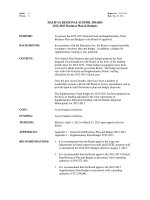Business Plan Templates Projections_7 docx
Bạn đang xem bản rút gọn của tài liệu. Xem và tải ngay bản đầy đủ của tài liệu tại đây (97.67 KB, 12 trang )
Financier
Management
and staff
Analysts
Supplier
Board
PRACTICAL PLANNING
COMMUNICATING A PLAN
It is up to you to make sure that your plan
communicates well to the reader.
Each reader will have different
needs, albeit with a high
degree of commonality.
You should decide on
whether you need to
prepare different
versions for different
audiences.
81
PRACTICAL PLANNING
COMMUNICATING A PLAN
THE PYRAMID
In communicating a plan, remember to make your message stand out.
Adopt a pyramidal approach:
● Key message in the summary
● Supporting points in the main body
● Real details in the appendices
● Allow readers to drill down to the level they require
● Summary is a stand-alone document
82
Key
points
level of interest
Key
points
level of interest
Too much
detail
Detail only
supporting
key points
TYPICAL PLAN
IDEAL PLAN
PRACTICAL PLANNING
COMMUNICATING A PLAN
You must tailor the level of information to ensure that you hold attention. Do not clutter
it with inessential detail.
83
PRACTICAL PLANNING
USING A PLAN
A plan is of no use whatsoever unless it is used. This means that the theoretical
thinking must be translated into something tangible - action.
The plan is only a route map and must be used as such. On a regular basis you must
take time to look at where you are and compare and contrast your position with what you
had planned. You should then take action to put yourself back on course if you are adrift,
to change course if events demand it, or alter the plan to reflect reality.
Typically, given that a plan is short-term, most measurement against it tends to be
budgetary variance analysis, and subsequent investigation into the reasons. However,
the plan was prepared to indicate your intentions for the future, and as such should be
used in the same way as you might use a road map. Consult the plan regularly to ensure
that you are following the steps - they will usually have been the output of much thought
and deliberation and will help you.
84
PRACTICAL PLANNING
USING A PLAN
To ensure maximum use of your plan it is very important to take regular stock
of where you are. This usually involves preparing a report indicating current
progress and reasons for non-achievement. Depending on the type of business,
you will either review this yourself (sole trader, partner, small business) or present
it at a more formal forum, eg: monthly management meetings. Typical contents
of a report would be:
● Management summary
● Profit and Loss account; this month and YTD
● Balance sheet; this month and YTD
● Analysis of business area performance
● Expense analysis
● Sales commentary
● Revised year end forecasts
● Capital utilisation
● Actions for next period
85
PRACTICAL PLANNING
CONTINGENCY PLANNING
Not everything goes according to plan; in fact, this is rarely, if ever, the case. You
should therefore look at possible problems and develop a strategy for dealing with them.
It is not the expected problems that cause difficulties; but rather the unexpected
problems.
A good way of looking at these is to contrast the probability of an event with the
magnitude of damage if it occurs. For example, an earthquake might be unlikely in, say,
the UK but could devastate your business if it occurred. (In California, however, it will be
much more probable.) An employee is likely to be sick occasionally but this should not
seriously damage your business, unless that person has an indispensable role.
The combination of the two allows you to plan contingency action to cover the issues.
The chart on the next page shows one organisation’s analysis and weighting of risks.
86
PRACTICAL PLANNING
RISK ASSESSMENT MATRIX
87
LIKELIHOOD OF RISK
COMPLETE
DISASTER
EXTREMELY
SEVERE
DAMAGING
SOME LOSS
ALMOST
NOTHING
ALMOST
IMPOSSIBLE
VERY
UNLIKELY
UNLIKELY LESS THAN
EVEN CHANCE
EVEN
CHANCE
MORE THAN
EVEN CHANCE
PROBABLE VERY
LIKELY
ALMOST
CERTAIN
RISK
CATEGORY
AVOID LAY-OFF (INSURE) QUANTIFY ABSORB IGNORE
S
E
V
E
R
I
T
Y
O
F
R
I
S
K
9
8
7
6
5
4
3
2
1
0 1 2 3 4 5 6 7 8 9
PRACTICAL PLANNING
CONTINGENCY PLANNING
There are many events that can have adverse impacts on your business - they will
depend upon the exact nature of your markets and the supply chain, environment, etc.
Below is a list of some of these; however, it is neither exhaustive nor exclusive so you
must think them through for yourself and ensure that your plan addresses them:
● Strikes - your own staff or suppliers, distributors
● Price war - in your market or suppliers, substitute goods
● Legislation change - positive or negative
● Change of government
● Embargo - goods in or out
● Plant failure
● Fire
● Inflation
● Currency fluctuations
● Technological obsolescence
● ‘Shocks’ - eg: oil price rise in 70s
88
PRACTICAL PLANNING
ORGANISING TO PLAN
The way you organise for your planning will vary depending on the type and size
of the organisation:
● Sole traders will often do it themselves; perhaps with the help of a financial adviser
● A unit manager will plan him/herself, perhaps involving key staff
● Very large organisations often have planning departments, not to mention
cumbersome time-consuming processes
● Others are totally decentralised
● Some have small central bodies which carry out forecasting, macro-economic
analysis and set group targets; which are then cascaded down the organisation
to form planning frameworks
89
PRACTICAL PLANNING
ORGANISING TO PLAN
● Clearly you will have to work within your constraints but you should try to
produce a plan using the minimum resources to carry out a cost-effective job
● Whilst successful organisations tend to spend more time planning than those
that are unsuccessful, the law of diminishing returns sets in quite quickly
● The style of planning should fit in with your organisation and reflect the
way it works
90
strategic planning group
unit 1 unit 2 unit N
sub-unit
planning sub-group
PRACTICAL PLANNING
ORGANISING TO PLAN
Typical planning hierarchy in a large organisation
91
PRACTICAL PLANNING
PLANNING CYCLE
Every organisation will have a different planning cycle driven by the fiscal needs,
the type of organisation and the type of planning in use. Usually, however, the
planning cycle is the same each year. A typical cycle would be as follows:
● Central unit(s) carry out socio-political economic forecasts to review trends
that will impact the business
● Based on these, guidelines will be set for the units
● The strategy will be reviewed for any changes as a result of shifts in the environment
● This will be communicated along with the guidelines, last year’s plans and results
as well as dates for submission of this year’s plan
● Units prepare their plans and budgets and a process of review and iteration
takes place
● The final plans are agreed and signed off in time for the next year
Typical timings are shown on the next page.
92









